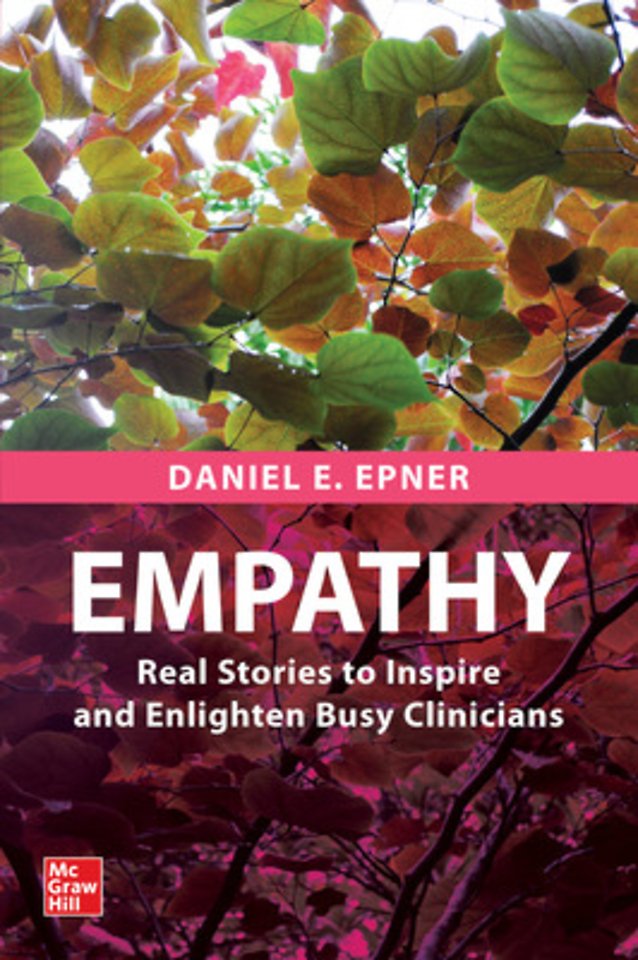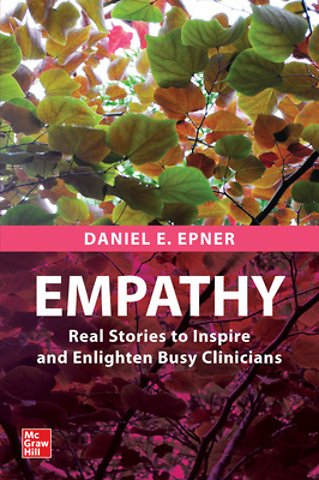Empathy: Real Stories to Inspire and Enlighten Busy Clinicians
Samenvatting
For anyone who communicates directly with patients—the complete guide to handling emotionally charged conversations with the empathy vulnerable people deserve
Empathy: Real Stories to Inspire and Enlighten Busy Clinicians helps you approach tough conversations with patients in a new, more effective way―by imagining what patients and their families may be thinking and feeling, and then communicating that recognition clearly and confidently. The authors use stories to illustrate what empathy looks and sounds like on an operational level―rather than a theoretical, scientific, or conceptual level―and provide the actionable advice you need to make empathy the central focus when faced with challenging scenarios, such as “denial,” questions about prognosis, existential concerns, difficult family dynamics, anger, and nonmedical opiate use.
The viewpoints presented are drawn from a diverse group of clinicians from a variety of medical disciplines, including oncology, palliative medicine, pediatrics, psychology, chaplaincy, and ophthalmology. Each chapter is anchored by a true but anonymized story that clearly illustrates how empathy can unfold in the clinical setting. Vignettes throughout provide sample dialogue and examples of actual words and phrases that help clinicians connect with patients under the most trying circumstances.
Much more than a guide to breaking bad news or an overview of all communication skills, Empathy: Real Stories to Inspire and Enlighten Busy Clinicians is a must-read for anyone connected to the healthcare industry.
Specificaties
Inhoudsopgave
pt; font-style: italic; font-weight: normal;'><p><span>"I don’t want to talk to my kids about this. I need to be strong for them"</span></p></li><li style='color: rgb(0, 0, 0); font-family: "Times New Roman",serif; font-size: 12pt; font-style: italic; font-weight: normal;'><p><span>“Who will raise my family if I die?”</span></p></li><li style='color: rgb(0, 0, 0); font-family: "Times New Roman",serif; font-size: 12pt; font-style: italic; font-weight: normal;'><p><span>“Will my children remember me?”</span></p></li></ul><p><br></p><p><span> </span></p><p><br></p><p><span> </span></p><p><br></p><p><strong><span>Chapter 10: Empathy and Pediatric Care</span></strong></p><p><br></p><p><span> </span></p><p><br></p><p><span>Kevin Madden, M.D., </span><span>pediatric palliative specialist and Professor at M.D. Anderson.</span></p><p><br></p><p><span> </span></p><p><br></p><p><span>This chapter addresses t</span><span>he lopsided triangle of pediatric care: supporting ill children and their parents with great finesse.</span></p><p><br></p><ul style="list-style-type: disc; direction: ltr;"><li style='color: rgb(0, 0, 0); font-family: "Times New Roman",serif; font-size: 12pt; font-style: italic; font-weight: normal;'><p><span>"I can't stop life support. This is my daughter. I can't give up on her."</span></p></li></ul><p><br></p><p><span> </span></p><p><br></p><p><strong><span>Chapter11: Difficult Family Dynamics</span></strong></p><p><br></p><p><span> </span></p><p><br></p><p><span>Authors TBD</span></p><p><br></p><p><span> </span></p><p><br></p><ul style="list-style-type: disc; direction: ltr;"><li style='color: rgb(0, 0, 0); font-family: "Times New Roman",serif; font-size: 12pt; font-style: italic; font-weight: normal;'><p><span>“Please don’t tell my mother she has cancer or any other bad news.”</span></p></li><li style='color: rgb(0, 0, 0); font-family: "Times New Roman",serif; font-size: 12pt; font-style: italic; font-weight: normal;'><p><span>“Oh, it doesn’t matter what he thinks. He may be the sick one, but we make his decisions for him.”</span></p></li><li style='color: rgb(0, 0, 0); font-family: "Times New Roman",serif; font-size: 12pt; font-style: italic; font-weight: normal;'><p><span>“I know my daughter is suffering greatly, but she said, ‘Never give up on me.’ I have to honor her wishes, so I can’t make her DNR.”</span></p></li></ul><p><br></p><p><span> </span></p><p><br></p><p><span> </span></p><p><br></p><p><strong><span>Chapter 12: Dealing with Anger and Blame </span></strong></p><p><br></p><p><span> </span></p><p><br></p><p><span> Laura Meyer and co-author TBD</span></p><p><br></p><p><span> </span></p><p><br></p><ul style="list-style-type: disc; direction: ltr;"><li style='color: rgb(0, 0, 0); font-family: "Times New Roman",serif; font-size: 12pt; font-style: italic; font-weight: normal;'><p><span>“Of course, I’m depressed! Wouldn’t you be if you were told you are going to die?”</span></p></li><li style='color: rgb(0, 0, 0); font-family: "Times New Roman",serif; font-size: 12pt; font-style: italic; font-weight: normal;'><p><span>“This place has failed me miserably.”</span></p></li><li style='color: rgb(0, 0, 0); font-family: "Times New Roman",serif; font-size: 12pt; font-style: italic; font-weight: normal;'><p><span>“You can’t possibly understand how I feel. I’m dying, and I’m only 36! You are perfectly healthy. Don’t try to convince me to feel better with your psychological mumbo jumbo.”</span></p></li></ul><p><br></p><p><span> </span></p><p><br></p><p><span> </span></p><p><br></p><p><span><strong>Chapter 13: The question of opiates and uncontrolled pain.</strong> </span></p><p><br></p><p><span> </span></p><p><br></p><p><span>Joseph Arthur M.D., Assistant Professor at M.D. Anderson and <span>Daniel Epner, M.D.</span></span></p><p><br></p><p><span> </span></p><p><br></p><ul style="list-style-type: disc; direction: ltr;"><li style='color: rgb(0, 0, 0); font-family: "Times New Roman",serif; font-size: 12pt; font-style: italic; font-weight: normal;'><p><span>“Doc, I know where you’re going with this. I hate to be asked all these questions all the time. You’re talking to me like I’m a criminal and you think I’m taking these meds and trying to sell them.”</span></p></li><li style='color: rgb(0, 0, 0); font-family: "Times New Roman",serif; font-size: 12pt; font-style: italic; font-weight: normal;'><p><span>"I've been giving my son some of my pain medication."</span></p></li><li style='color: rgb(0, 0, 0); font-family: "Times New Roman",serif; font-size: 12pt; font-style: italic; font-weight: normal;'><p><span>“I've been coming to this clinic for 2 years, and every doctor has given me the meds I need. You are the first doctor who has denied me.”</span></p></li><li style='color: rgb(0, 0, 0); font-family: "Times New Roman",serif; font-size: 12pt; font-style: italic; font-weight: normal;'><p><span>"You don't know how I feel. I may not look like I’m hurting, but I have a high pain tolerance. I need meds."</span></p></li></ul><p><br></p><p><span> </span></p><p><br></p><p></p><strong><p><span>Chapter 14: Empathy and Culture</span></p></strong><p><br></p><p><span> </span></p><p><br></p><p><span> Laura Meyer and Daniel Epner, M.D. </span></p><p><br></p><p><span>Using a case to exemplify person-centered care, the authors demonstrate how to engage with and respect patients of all cultures and backgrounds. This chapter outlines </span><span>universal truths about empathic practice with patients and coworkers from all over the world: we all want the same things, and we are all deserving of empathy. </span></p><p><br></p><p><span> </span></p><p></p><strong><p><br></p><p><span>Chapter 15: Empathy and <strong><span>Spirituality</span></strong></span></p></strong><p><br></p><p><span> </span></p><p><br></p><p><span>Marvin Delgado, M.D., Associate Professor at M.D. Anderson and </span></p><p><br></p><p><span>Alejandro Chaoul PhD, Assistant Professor at M.D. Anderson</span></p><p><br></p><p><span> </span></p><p><br></p><p><span>In chapter 15, the authors demonstrate how a clinician can hold respectful space for the patient’s spiritual needs or practices. The authors reflect on how empathy can be expressed effectively in encounters where spirituality (or a lack there of)emerges.</span></p><p><br></p><ul style="list-style-type: disc; direction: ltr;"><li style='color: rgb(0, 0, 0); font-family: "Times New Roman",serif; font-size: 12pt; font-style: italic; font-weight: normal;'><p><span>“Do you believe in miracles?”</span></p></li><li style='color: rgb(0, 0, 0); font-family: "Times New Roman",serif; font-size: 12pt; font-style: italic; font-weight: normal;'><p><span> “I can’t believe God would abandon me like this.”</span></p></li></ul><p><br></p><p><span> </span></p><p><br></p><p><strong><span>Chapter 16: Empathy and Technology</span></strong></p><p><br></p><p><span> </span></p><p><br></p><p><span>Ali Haider, M.D., Assistant Professor at M.D. Anderson and</span></p><p><br></p><p><span>Kimberson Tanco, M.D., Assistant Professor at M.D. Anderson</span></p><p><br></p><p><span> </span></p><p><br></p><p><span>Chapter 16 illustrates how </span><span>empathy is adapted to overcome the modern realities where there are computers in every exam room and the electronic medical record sometimes pulls the clinician’s attention away from the patient. </span></p><p><br></p><p><span> </span></p><p><br></p><p><strong><span>Chapter 17: Focus on process rather than rainbows</span></strong></p><p><br></p><p><span> </span></p><p><br></p><p><span> Author TBD & Laura Meyer</span></p><p><br></p><p><span> </span></p><p><br></p><p><span>Describes unresolved predicaments, such as those involving patients with personality disorders, who sometimes do not respond to empathy, or those who have no spiritual foundation in their lives and therefore are never able to process the various stages of grief.</span><span> Sometimes it is impossible to connect with patients or families despite our best efforts. This chapter reinforces the premise that learners should continue to shape and refine their own “art of medicine” through all encounters, positive or negative. </span></p><p><br></p><p><span> </span></p><p><br></p><p><span>Section 3: Compact Empathic Responding Summary</span></p><p><br></p><p><span> </span></p><p><br></p><p><span>An abbreviated version of Chapters 6-17. </span></p><p><br></p><p><span> </span></p><p><br></p><p><span> </span></p><p><br></p><p><span> </span></p><p><br></p><p><br></p><p><br></p>
Net verschenen
Rubrieken
- aanbestedingsrecht
- aansprakelijkheids- en verzekeringsrecht
- accountancy
- algemeen juridisch
- arbeidsrecht
- bank- en effectenrecht
- bestuursrecht
- bouwrecht
- burgerlijk recht en procesrecht
- europees-internationaal recht
- fiscaal recht
- gezondheidsrecht
- insolventierecht
- intellectuele eigendom en ict-recht
- management
- mens en maatschappij
- milieu- en omgevingsrecht
- notarieel recht
- ondernemingsrecht
- pensioenrecht
- personen- en familierecht
- sociale zekerheidsrecht
- staatsrecht
- strafrecht en criminologie
- vastgoed- en huurrecht
- vreemdelingenrecht

